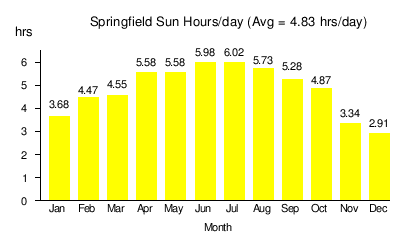Solar power in Illinois
Solar power in Illinois has been increasing, as the cost of photovoltaics has decreased. Illinois adopted a net metering rule which allows customers generating up to 40 kW to use net metering, with the kilowatt hour surplus rolled over each month, and lost at the end of either April or October, as selected by the customer. In 2011, the limit was raised to 2 MW, but is not net metering, as the term is commonly known, as it uses two meters for systems larger than 40 kW.[1]
Illinois ranks 26th nationally in cumulative installed solar capacity. There is enough solar energy installed in the state to power 9,500 homes.[2]
A 2012 estimate suggests that a typical 5 kW system will pay for itself in about nine years.[3] Additionally, a 5 kW system could end up adding around $10,000 to the value of your home. Reports have also shown that a home with a solar panel system will end up selling approximately 15% faster than a home without. Illinois also offers up to a $10,000 tax credit for a solar installation.[4]
In 2002, Illinois' largest solar array was the 99.4 kW array on the roof of the Field Museum of Natural History, in Chicago.[5]
In 2010 the country's largest urban solar array, 10 MW, was installed in West Pullman, on Chicago's south side.[6] In 2012, IKEA installed solar PV on its two stores in Bolingbrook and Schaumburg totaling almost 2 MW.[7] Also in 2012, the 20 MW Grand Ridge Solar Plant in LaSalle County was completed.[2] The University of Illinois built a 5.87 MW solar farm in 2015 which will provide 2% of the university's electricity.[8][9]
The first experimental solar power plant was in 1902, in Olney, Illinois, by H.E. Willsie and John Boyle, and was based on a design by Charles Tellier.[10] In 1904 they set up the Willsie Sun company in St. Louis, and built a 6-horsepower motor.[11]
In November 2016, ComEd (one of the state's utility) attempted to add additional fees to the bills of only residential solar users, commonly called demand charges, in the text of a wider energy bill.[12] They were eventually pulled out of the bill,[13] which passed in December 2016 without them (the bill also did not repeal net-metering, the practice of compensating solar customers at the retail rate for any excess electricity they produce and export to the grid).[14]
Statistics

|
| Illinois Grid-Connected PV Capacity (MW)[16][17][18][19][20][21][22][23] | |||
|---|---|---|---|
| Year | Capacity | Installed | % Change |
| 2007 | 2.2 | 0.2 | 10% |
| 2008 | 2.8 | 0.4 | 27% |
| 2009 | 4.5 | 1.7 | 61% |
| 2010 | 15.5 | 11.0 | 244% |
| 2011 | 16.2 | 0.7 | 5% |
| 2012 | 42.9 | 26.7 | 165% |
| 2013 | 43.4 | 0.5 | 1% |
| 2014 | 54 | 10.6 | 24% |
| 2015 | 65 | 11 | 20% |
| 2016 | 70 | 5 | 8% |
See also
References
- ↑ Illinois - Net Metering
- 1 2 Illinois Solar, Solar Energy Industries Association,accessed May 19, 2016
- ↑ Illinois
- ↑ Solar in Illinois
- ↑ A greener field - Energy
- ↑ Solar power may get chance to shine in Illinois
- ↑ , IKEA, July 25, 2012
- ↑ Solar farm connected to UIUC grid, Anna Carrera, 11/19 2015
- ↑ Updated: Solar farm construction to start in spring at UI, The News-Gazette, January 20, 2015
- ↑ Solar Power in Olney, Illinois
- ↑ Environmental History Timeline
- ↑ "Bill for massive coal, nuclear bailout, residential demand charges introduced in Illinois". pv magazine USA. Retrieved 2017-07-21.
- ↑ "BREAKING: Demand charges removed from Illinois nuke bailout bill". pv magazine USA. Retrieved 2017-07-21.
- ↑ "Illinois energy bill passes without demand charges or repeal of net metering". pv magazine USA. Retrieved 2017-07-21.
- ↑ "PV Watts". NREL. Retrieved 21 June 2012.
- ↑ Sherwood, Larry (August 2012). "U.S. Solar Market Trends 2011" (PDF). Interstate Renewable Energy Council (IREC). Archived from the original (PDF) on 2012-09-06. Retrieved 2012-08-16.
- ↑ Sherwood, Larry (June 2011). "U.S. Solar Market Trends 2010" (PDF). Interstate Renewable Energy Council (IREC). Retrieved 2011-06-29.
- ↑ Sherwood, Larry (July 2010). "U.S. Solar Market Trends 2009" (PDF). Interstate Renewable Energy Council (IREC). Archived from the original (PDF) on 2010-09-25. Retrieved 2010-07-28.
- ↑ Sherwood, Larry (July 2009). "U.S. Solar Market Trends 2008" (PDF). Interstate Renewable Energy Council (IREC). Archived from the original (PDF) on 2009-11-23. Retrieved 2010-07-24.
- ↑ Sherwood, Larry (July 2009). "U.S. Solar Market Trends 2008" (PDF). Interstate Renewable Energy Council (IREC). p. 16. Archived from the original (PDF) on 2009-11-23. Retrieved 2010-07-24.
- ↑ Sherwood, Larry (July 2012). "U.S. Solar Market Trends 2012" (PDF). Interstate Renewable Energy Council (IREC). p. 16. Retrieved 2013-10-11.
- ↑ Sherwood, Larry (July 2014). "U.S. Solar Market Trends 2013" (PDF). Interstate Renewable Energy Council (IREC). Retrieved 2014-09-26.
- ↑ Illinois Solar
External links
| Wikimedia Commons has media related to Solar power in Illinois. |
- GA Mansoori, N Enayati, LB Agyarko (2016), Energy: Sources, Utilization, Legislation, Sustainability, Illinois as Model State, World Sci. Pub. Co., ISBN 978-981-4704-00-7
- Illinois Solar Energy Association
- Incentives and policies